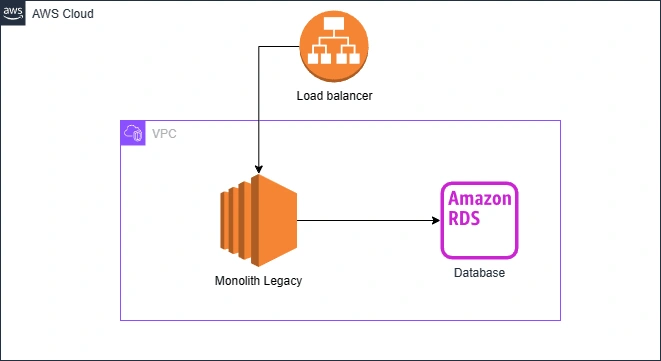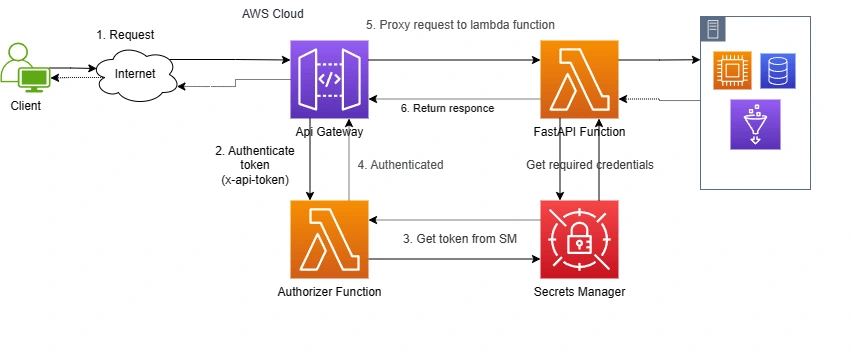API Gateway + Lambda + FastAPI + Docker + SAM
The client approached with the challenge of building a scalable and cost-effective backend solution to support their expanding business operations. They required a robust infrastructure capable of handling high traffic volumes, ensuring low latency, and seamlessly integrating with their existing systems.
Challenges:
Scalability: The client needed a solution that could easily scale to accommodate fluctuations in traffic and user demand.
Cost Efficiency: Cost management was crucial for the client, who sought to minimize infrastructure expenses without compromising performance.
Performance: The backend solution needed to deliver response in timely manner to provide a smooth user experience.
Integration: Seamless integration with existing systems, including third-party services and databases, was essential to streamline business processes.
Time to Market: The client faced pressure to launch new features and updates quickly to remain competitive in the market. Time to market of the code was a critical factor in meeting business objectives.

The client has a legacy API deployed to EC2, and it is crucial for us to deliver new API endpoints as quickly as possible without involving the development teams that support legacy API in this process.
After carefully analyzing the client's requirements and considering various options, proposed a serverless architecture leveraging Amazon Web Services (AWS) services such as API Gateway, Lambda, Relational Database Service (RDS), AWS CodePipeline, AWS CloudFormation, and FastAPI, a high-performance web framework for building APIs with Python.

API Gateway: AWS API Gateway was utilized to create a fully managed API layer that acts as a front door for the backend services. API Gateway provides features such as authentication, authorization, request throttling, and monitoring, ensuring secure and reliable access to the backend APIs.
Lambda Functions: AWS Lambda, a serverless compute service, was leveraged to implement business logic and handle incoming API requests. Lambda allows code to run without provisioning or managing servers, automatically scaling to handle the workload. Modular and lightweight Lambda functions using Python were developed, which execute in response to API Gateway events.
FastAPI: FastAPI, chosen for building the API endpoints and defining data models, due to its high performance, easy-to-use interface, and built-in support for asynchronous programming. FastAPI's automatic OpenAPI documentation generation and data validation capabilities streamlined development and ensured API consistency.
RDS (Relational Database Service): Amazon RDS, a managed relational database service, was utilized to store and manage structured data, such as user profiles, product information, and order details. RDS supports multiple database engines, including PostgreSQL, MySQL, and MariaDB, providing scalability, reliability, and automated backups.
AWS Secrets Manager: AWS Secrets Manager was employed for securely storing and managing sensitive information such as database credentials, API keys, and other secrets. Secrets Manager provides encryption, rotation, and access control features, ensuring that secrets are protected and managed centrally.
AWS CodePipeline: AWS CodePipeline, a fully managed continuous integration and continuous delivery (CI/CD) service, was implemented to automate the build, test, and deployment process. CodePipeline orchestrated the release pipeline, enabling automatic code deployments and ensuring consistent and reliable software releases.
AWS CloudFormation: AWS CloudFormation, a service that allows defining infrastructure as code using a template, was utilized to automate the provisioning and management of AWS resources. CloudFormation templates enable repeatable and consistent infrastructure deployments, reducing the risk of configuration errors and simplifying resource management.
Conclusion:
By leveraging AWS services, a scalable, cost-effective, and high-performance backend solution was successfully built for the client. The serverless architecture, coupled with automated CI/CD and infrastructure as code, offers flexibility, reliability, and cost efficiency, enabling the client to focus on business growth and innovation while handling the backend infrastructure. The expedited time to market of the code ensures the client remains competitive and responsive to market demands.
Like this project
Posted May 20, 2024
Built scalable, cost-effective backend for client's growing operations. Ensured high traffic handling, low latency, and seamless system integration.
Likes
0
Views
23






